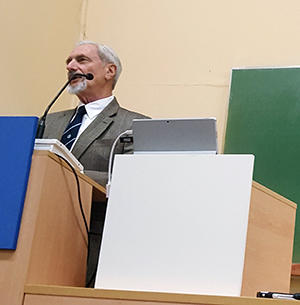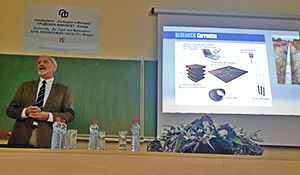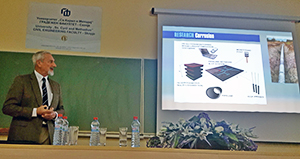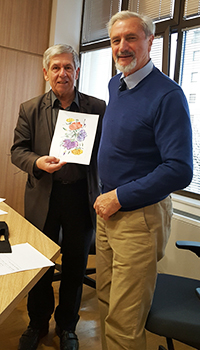
Professor Carlos A. Brebbia has given a special lecture on Fundamentals of the Boundary Element Method and its Applications in Industry at the School of Engineering of the University St. Cyril and St. Methodius in Skopje.
The speaker was introduced by Professor Darko Moslavac, Dean of the School. Ing. Mile Dimitrovski, in charge of International Relations at the Institute of Engineers and Architects, referred to the importance for these professionals to update their skills and be aware of the latest developments.
Carlos started by expressing his appreciation to the substantial number of colleagues attending the meeting, including many participants from industry. He was also grateful for the invitation, to Professor Moslavac, Ing. Dimitrovski and Professor Todorka Samardzioska, Vice Dean of Civil Engineering, who obtained her PhD at the Wessex Institute.
Carlos’s lecture concentrated on the fundamental concepts behind the Boundary Element theory and its relationship with other numerical techniques, particularly finite differences and finite elements. His approach was to focus on the common basis of all numerical methods and how this relates to a wider interpretation of the Principle of Virtual Work, the foundation stone for all numerical methods.
He described how the different methods, such as finite difference, finite elements and boundary elements, among other, can be interpreted as based on mixed principles and transformation of the governing equations. The idea is to propose an approximate functions and try to minimise the errors in different ways depending on the method under consideration.
The boundary element method is based on the elimination of the domain equations by the careful use of special functions (ie fundamental solutions). The result is a system of equations that relate the values of the boundary nodes to each other.


Carlos then explained through a series of examples the advantages of boundary elements in terms of simple mesh generation (ie only on the boundary. The domain does not need to be discretised); accuracy of results (as a consequence of the use of special, ie fundamental solution functions); moving meshes (which can follow moving boundaries); problems extending to infinity (ie due to the special character of the fundamental solution) and problems in which elements need to be added (such as in crack growth).
His conclusion was that the advantages of the method for many types of problem outweigh those methods such as finite elements. In addition, it is easy to combine both techniques, something that has been pioneered at the Wessex Institute.
His final remarks referred to the importance of boundary elements in terms of its suitability to interface with the Rapid (or Additive) Manufacturing machines. The future – Carlos thought – is in terms of integrating the analysis tools within the design and manufacturing processes. These developments are now taking place and their implementation will accelerate the dawning of a new industrial revolution. Boundary Elements, Carlos thinks, are well positioned to take advantage of this.The lecture was followed by a series of questions and remarks regarding other possible application of the methods.
Following the lecture, a visit was arranged to the new offices of the Institute of Engineers and Architectures, where further collaboration was discussed. At the end of the visit, Carlos was offered two paintings by Zivko Popvski, who specialises in the topic “Flowers for Peace”. He is currently President of the Macedonian Red Cross and was nominated for the Nobel Peace Prize in 2009.


 Wessex Institute
Wessex Institute